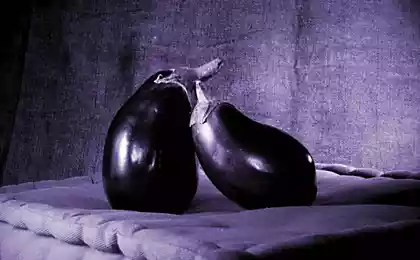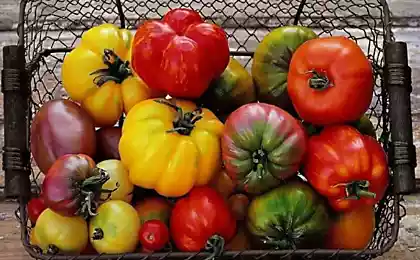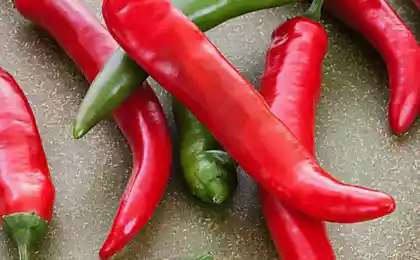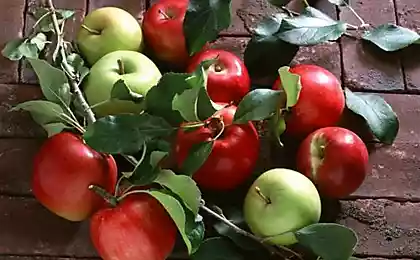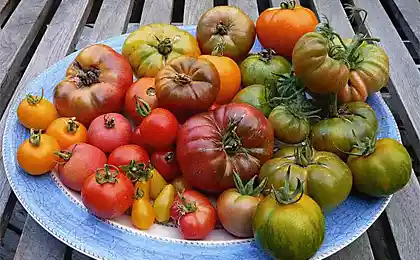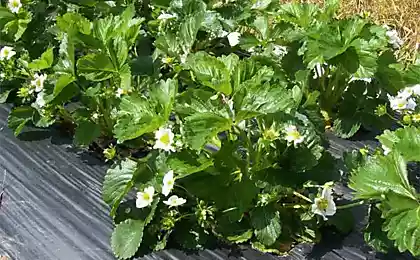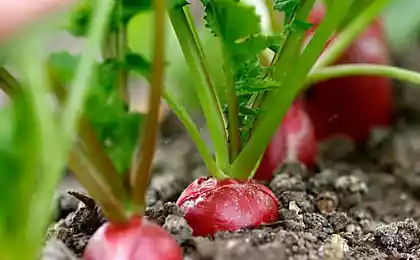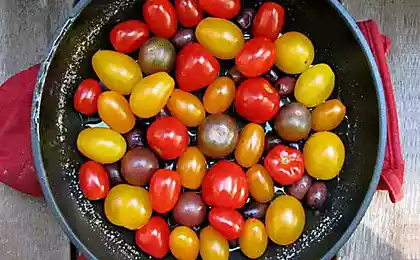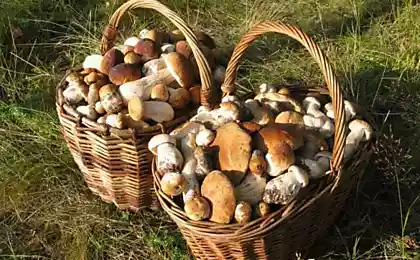485
How to get an early crop of tomatoes
How to get 20 to 25 June, the first ripe fruit
To 30 and even 45 kg of tomatoes per square meter can be obtained by every gardener in the open ground. Technology of growing seedlings of tomatoes available to most gardeners, it does not cost much, and the first ripe fruits, you can get 20 — 25 June.
Preparation of seeds begins in late January. First, seeds need to be heated at a temperature of 55 — 60°C, then placed in a 3 percent solution of salt, mix well. For sowing, use only those seeds which have settled to the bottom, they need to be washed under running water, then placed in a 1% solution of potassium permanganate (potassium permanganate) for 20 minutes. Then rinse again and dry at room temperature for one hour. The seeds are then soaked in a solution of micronutrients — a quarter of a tablet 2.5 l of water or the hood of the ash for 12 hours.Next, the seeds should be tempered — wrapped in gauze wet seeds alternately (for 12 hours) was kept at room temperature and at a temperature of minus 1 — 2°C. Tempering is carried out for 12 days. After that, seeds are sown in boxes in the first half of February.
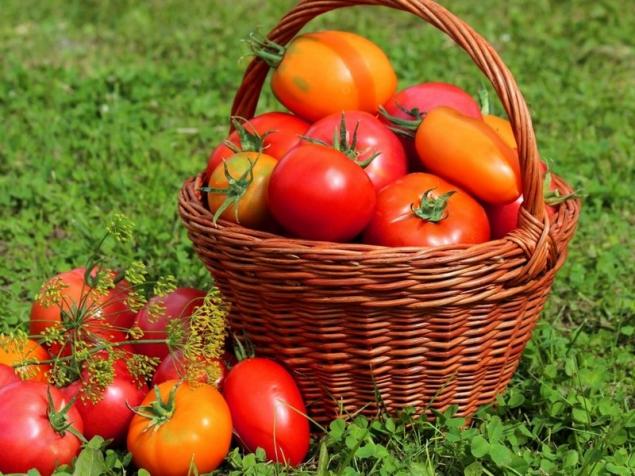
The soil mixture needs to cook in the summer. It consists of loam, manure humus and lowland peat and 1 bucket of each component. The mixture is dressed with fertilizers: nitroammophos — 100 g of double superphosphate, 200 g, kalimagnesia — 100 g and ash from the burning of foliage of tomatoes 1.5 liters. A nutrient mixture is saturated in autumn, before freezing. The thawed mixture is poured into boxes with a layer of 6-8 cm in shallow wells laid out the seeds, sprinkle ground, moisten and cover with foil. Boxes put in a warm place with a constant temperature of 25 — 28°C. seedlings Usually appear within 3 days.
In the first 2 — 2.5 weeks the seedlings need to illuminate every day for 12 — 14 hours (200 watts per 1 square meter), and the appearance of mass shoots the temperature should be lowered to 14 — 13°C during the week to ensure that the seedlings are stronger and better developed root system.
Then the temperature can be increase depending on the degree of illumination. Need to be watered no more than twice a week. Once formed, the second true leaf, seedlings need to raspikirovat in boxes with a depth of 12 cm under the scheme 5x5 cm, buried up to their cotyledon leaves. For the best survival immediately after picking to reduce lighting and full lighting to give only on the third day. Avoid contact with direct sunlight. Once the seedlings take root finally, you can give the maximum coverage.
The duration of lighting to bring to 14 hours a day with additional lighting. If at the end of March the weather conditions do not allow to move the seedlings in greenhouses, it is necessary to cause an artificial slowdown — reducing temperature to 10 — 12°C, reduce watering, reduce the lighting and gradually reduce the temperature to 8°C. to Inhibit the growth of plants can also sparring. Each pick is retards the growth of plants for a week and, besides the plants acquire resistance to adverse conditions. For removing plants from the state of preservation should gradually over 3 days to raise the temperature and illuminance, and after 6 days to give feeding.
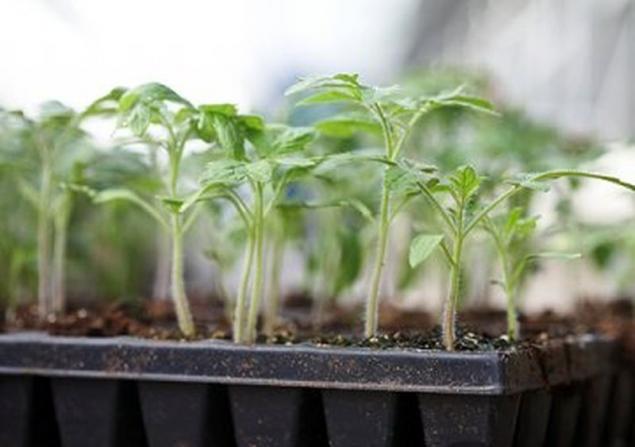
The solution for feeding to cook this way: 30 g of ammonium nitrate, 20 g of superphosphate, 15 g of potassium sulfate in 10 liters of water. There also pour in 100 ml of the aqueous extract of ash (1 Cup per 1 liter of water). Hood ash to cook for 1 day before feeding. The rate of 1 bucket per 1 square meter boxes.
To grow stocky, nevytyanutaya seedlings, it is necessary to adjust the ratio of the amounts of fertilizer in the soil mix. So, when preparing a mixture before you pick need to additionally add the same amount of superphosphate and ash, how much was made for the first time, the number of nitrogen remained at the same level, bordering on deficiency. This is a factor in the formation of stocky, powerful seedlings. If the color of the leaves will be a noticeable lack of nitrogen, nitrogen to give a foliar feeding of 20 g of ammonium nitrate to 10 l of water at the rate of 2 liters of solution per 1 square meter box. At the end of March, in the phase of 4 leaves of these seedlings need to dive, but in a greenhouse.
It is necessary to conduct a quiet day when the air temperature is below +8 degrees. Soil temperature in the greenhouse by this time should be 15 — 18°C. the Greenhouse is stuffed with autumn dried leaves for less freezing. Now they need to be removed, disinfected with 5% formalin solution and fill with manure. After the flare-up and subsidence of manure sprinkled a layer of ash 3 mm and fill with a layer of potting soil 15 — 18 cm
In him and planted seedlings under the scheme of 10 × 10 cm When the seedlings in the greenhouse will continue to heal, you need to spray of 0.1% boric acid solution, and a day to hold the fertilizer in a 12-liter bucket to pour 10 liters of infusion of chicken manure, 100 g of extracts from ash, 2.5 g of potassium permanganate, 1.5 g of boric acid. Before feeding plants with water — 5 liters per 1 sq. m with water temperature of 18°C. Feeding is carried out on row spacing at the rate of 100 ml per plant.
Before planting seedlings in the ground you need to adjust the temperature and humidity of the soil. In cold periods, the temperature can drop significantly. In this case, the greenhouse securely to cover the Kraft paper, mats. In the open ground seedlings are planted in late April when the first cyst form flower buds. If the weather allows, then you need to wait, but in the morning, spray with solution of boric acid (10 g per 10 liters of water) to prevent opadanie buds.
The soil before planting to prepare in advance: to loosen the iron rake and cover the dark film. This will provoke the growth of weeds when they start off in growth, they will be easy to destroy by repeated harrowing. On the eve of this operation, you need to place fertilizers: nitroammophos — 30g, ammonium sulfate 20g, kalimagnesia — 20 g, potassium sulfate — 20 g per 1 sq. m. plot and Then to dig without turning the reservoir at a depth of 30 cm.
The scheme of planting varieties "White filling": between the rows, arranged from North to South and 35 cm in the row between the centers of the holes is 30 cm In each row for 4 rows, width of the aisle between the beds is 50 cm. For one hundred square meters (100 sq. m.) is located 1 000 plants. Dig holes with a depth of 30 cm In each hole, pour half a liter of a fertilizer mixture consisting of 1 bucket of sifted compost, a half-liter of ash from burning of foliage of tomatoes and potatoes, half a Cup of double superphosphate, half a Cup of nitroammophos, 30 — 40 g kalimagnesia. This mixture should be prepared in advance, mix thoroughly.
In addition to the fertilizer mixture pour half a liter of a solution of chicken manure and 2 gallons of water. When the water is absorbed, mix the soil with fertilizer. In a doughy mass planted seedlings with a large lump of earth. To bury in the cotyledonary leaves. After 1 hour, pour 1 litre of water per plant. When the garden bed is planted with four rows, place of the arc of thick wire (diameter 8 — 10 mm) over 60 cm from each other. Arc bonding cord in 4 rows (on each row). Just in case of bad weather to prepare a double layer of plastic film with gasket in between the Kraft paper (3 layers).
Planting seedlings to a permanent place is best done in cloudy, wet weather. If the weather is Sunny, early in the morning or evening. Once the plants take root in a new place, at the beginning of flowering it is necessary to spray of 0.1% boric acid solution.
If in the flowering stage will go a protracted rains, it is better to patch with arcs to cover with a film.
All plants need to form a single stem with three buds. Delete unwanted stepchild until then, until the harvest at the last inflorescence and then produce stamping — to cut off the top. Days 20 — 30 prior to fruit ripening to produce root fertilizer through mulch layers: for every bucket of compost to add half a liter of ash and a Cup of double superphosphate. The prevalence in the soil of phosphorus and potassium over nitrogen accelerates ripening. Simultaneously with the removal of laterals, need to be tied with ribbons to the arc and the cord, which arc linked. This method eliminates the garter to a peg and reduces the load on the plant.
Plants, fruiting in June and July almost always go from a Phytophthora. In order of prevention, you can spray the plant extract of garlic 200 g of crushed Zubkov to insist in 1 bucket of water, tightly closing it. Spray 10-15 days starting from the end of July.
It must be emphasized this high-yielding variety as "De Barao". In form the fruit resembles an egg, high taste qualities. Taken in the autumn, they can be stored until January. The exclusive features of the variety are high yield per unit area (up to 45 kg per 1 sq. m.), cold resistance, weak susceptibility of diseases, including blight.
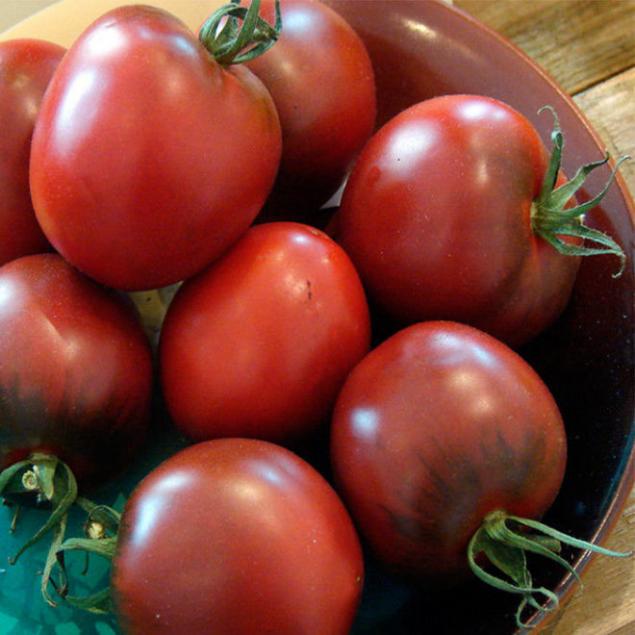
Sort of "De-Barao" grows well and bears fruit in the residential environment. Growers experiencing dozens of years, many varieties of tomatoes, came to the conclusion that "De-Barao" — the best variety of tomato.
Growing "De-Barao" has its own characteristics. It requires more nutritious soil mix for seedlings and for making holes. The mixture for planting consists of two parts of compost of horse manure and one part humus. To this mass add 10% sand, a half-liter of ash and half a Cup of double superphosphate per bucket of mix. The soil mixture should be prepared in September, in winter it could well be nipped by the frost. At the end of January mix otchaivatsya, in early February — shaping and hardening of the seeds, followed by sowing. The first pick is in stage of two true leaves spend in the apartment, the second in the greenhouse in early April — in the phase 3 — 4 true leaves. 2 through 10 may the seedling is planted in the open ground.
Planting pits are doing a volume of 10 m. within each poured in 3 l of nutrient mixture (in a bucket of humus — a pint of wood ashes, half a Cup of superphosphate, half a Cup of nitroammophos, 50 g kalimagnesia), and when the nutrient solution is absorbed — add another 3 liters of water. Stir the mixture with soil and planted seedlings, buried her in the cotyledonary leaves.
An hour after landing to water each plant in 1.5 liters of water, mulch with humus, it will save you from having to loosen the soil. Throughout the growing season, fertilizing is required — in plants a large stock of root food. To accelerate the process of fruit ripening can Perigny at the last mulching to add for every 10 litres for a half-liter of ash and glass double superphosphate. Plants form three stem and placed in a checkerboard pattern with the distance between plants at 70 cm maximum height of the plant after pinching should be up to 2 meters. published
Author: Vyacheslav Patlakh
P. S. And remember, just changing your mind — together we change the world! ©
Source: //midgard-svaor.com/pomidornaya-tajna/
To 30 and even 45 kg of tomatoes per square meter can be obtained by every gardener in the open ground. Technology of growing seedlings of tomatoes available to most gardeners, it does not cost much, and the first ripe fruits, you can get 20 — 25 June.
Preparation of seeds begins in late January. First, seeds need to be heated at a temperature of 55 — 60°C, then placed in a 3 percent solution of salt, mix well. For sowing, use only those seeds which have settled to the bottom, they need to be washed under running water, then placed in a 1% solution of potassium permanganate (potassium permanganate) for 20 minutes. Then rinse again and dry at room temperature for one hour. The seeds are then soaked in a solution of micronutrients — a quarter of a tablet 2.5 l of water or the hood of the ash for 12 hours.Next, the seeds should be tempered — wrapped in gauze wet seeds alternately (for 12 hours) was kept at room temperature and at a temperature of minus 1 — 2°C. Tempering is carried out for 12 days. After that, seeds are sown in boxes in the first half of February.

The soil mixture needs to cook in the summer. It consists of loam, manure humus and lowland peat and 1 bucket of each component. The mixture is dressed with fertilizers: nitroammophos — 100 g of double superphosphate, 200 g, kalimagnesia — 100 g and ash from the burning of foliage of tomatoes 1.5 liters. A nutrient mixture is saturated in autumn, before freezing. The thawed mixture is poured into boxes with a layer of 6-8 cm in shallow wells laid out the seeds, sprinkle ground, moisten and cover with foil. Boxes put in a warm place with a constant temperature of 25 — 28°C. seedlings Usually appear within 3 days.
In the first 2 — 2.5 weeks the seedlings need to illuminate every day for 12 — 14 hours (200 watts per 1 square meter), and the appearance of mass shoots the temperature should be lowered to 14 — 13°C during the week to ensure that the seedlings are stronger and better developed root system.
Then the temperature can be increase depending on the degree of illumination. Need to be watered no more than twice a week. Once formed, the second true leaf, seedlings need to raspikirovat in boxes with a depth of 12 cm under the scheme 5x5 cm, buried up to their cotyledon leaves. For the best survival immediately after picking to reduce lighting and full lighting to give only on the third day. Avoid contact with direct sunlight. Once the seedlings take root finally, you can give the maximum coverage.
The duration of lighting to bring to 14 hours a day with additional lighting. If at the end of March the weather conditions do not allow to move the seedlings in greenhouses, it is necessary to cause an artificial slowdown — reducing temperature to 10 — 12°C, reduce watering, reduce the lighting and gradually reduce the temperature to 8°C. to Inhibit the growth of plants can also sparring. Each pick is retards the growth of plants for a week and, besides the plants acquire resistance to adverse conditions. For removing plants from the state of preservation should gradually over 3 days to raise the temperature and illuminance, and after 6 days to give feeding.

The solution for feeding to cook this way: 30 g of ammonium nitrate, 20 g of superphosphate, 15 g of potassium sulfate in 10 liters of water. There also pour in 100 ml of the aqueous extract of ash (1 Cup per 1 liter of water). Hood ash to cook for 1 day before feeding. The rate of 1 bucket per 1 square meter boxes.
To grow stocky, nevytyanutaya seedlings, it is necessary to adjust the ratio of the amounts of fertilizer in the soil mix. So, when preparing a mixture before you pick need to additionally add the same amount of superphosphate and ash, how much was made for the first time, the number of nitrogen remained at the same level, bordering on deficiency. This is a factor in the formation of stocky, powerful seedlings. If the color of the leaves will be a noticeable lack of nitrogen, nitrogen to give a foliar feeding of 20 g of ammonium nitrate to 10 l of water at the rate of 2 liters of solution per 1 square meter box. At the end of March, in the phase of 4 leaves of these seedlings need to dive, but in a greenhouse.
It is necessary to conduct a quiet day when the air temperature is below +8 degrees. Soil temperature in the greenhouse by this time should be 15 — 18°C. the Greenhouse is stuffed with autumn dried leaves for less freezing. Now they need to be removed, disinfected with 5% formalin solution and fill with manure. After the flare-up and subsidence of manure sprinkled a layer of ash 3 mm and fill with a layer of potting soil 15 — 18 cm
In him and planted seedlings under the scheme of 10 × 10 cm When the seedlings in the greenhouse will continue to heal, you need to spray of 0.1% boric acid solution, and a day to hold the fertilizer in a 12-liter bucket to pour 10 liters of infusion of chicken manure, 100 g of extracts from ash, 2.5 g of potassium permanganate, 1.5 g of boric acid. Before feeding plants with water — 5 liters per 1 sq. m with water temperature of 18°C. Feeding is carried out on row spacing at the rate of 100 ml per plant.
Before planting seedlings in the ground you need to adjust the temperature and humidity of the soil. In cold periods, the temperature can drop significantly. In this case, the greenhouse securely to cover the Kraft paper, mats. In the open ground seedlings are planted in late April when the first cyst form flower buds. If the weather allows, then you need to wait, but in the morning, spray with solution of boric acid (10 g per 10 liters of water) to prevent opadanie buds.
The soil before planting to prepare in advance: to loosen the iron rake and cover the dark film. This will provoke the growth of weeds when they start off in growth, they will be easy to destroy by repeated harrowing. On the eve of this operation, you need to place fertilizers: nitroammophos — 30g, ammonium sulfate 20g, kalimagnesia — 20 g, potassium sulfate — 20 g per 1 sq. m. plot and Then to dig without turning the reservoir at a depth of 30 cm.
The scheme of planting varieties "White filling": between the rows, arranged from North to South and 35 cm in the row between the centers of the holes is 30 cm In each row for 4 rows, width of the aisle between the beds is 50 cm. For one hundred square meters (100 sq. m.) is located 1 000 plants. Dig holes with a depth of 30 cm In each hole, pour half a liter of a fertilizer mixture consisting of 1 bucket of sifted compost, a half-liter of ash from burning of foliage of tomatoes and potatoes, half a Cup of double superphosphate, half a Cup of nitroammophos, 30 — 40 g kalimagnesia. This mixture should be prepared in advance, mix thoroughly.
In addition to the fertilizer mixture pour half a liter of a solution of chicken manure and 2 gallons of water. When the water is absorbed, mix the soil with fertilizer. In a doughy mass planted seedlings with a large lump of earth. To bury in the cotyledonary leaves. After 1 hour, pour 1 litre of water per plant. When the garden bed is planted with four rows, place of the arc of thick wire (diameter 8 — 10 mm) over 60 cm from each other. Arc bonding cord in 4 rows (on each row). Just in case of bad weather to prepare a double layer of plastic film with gasket in between the Kraft paper (3 layers).
Planting seedlings to a permanent place is best done in cloudy, wet weather. If the weather is Sunny, early in the morning or evening. Once the plants take root in a new place, at the beginning of flowering it is necessary to spray of 0.1% boric acid solution.
If in the flowering stage will go a protracted rains, it is better to patch with arcs to cover with a film.
All plants need to form a single stem with three buds. Delete unwanted stepchild until then, until the harvest at the last inflorescence and then produce stamping — to cut off the top. Days 20 — 30 prior to fruit ripening to produce root fertilizer through mulch layers: for every bucket of compost to add half a liter of ash and a Cup of double superphosphate. The prevalence in the soil of phosphorus and potassium over nitrogen accelerates ripening. Simultaneously with the removal of laterals, need to be tied with ribbons to the arc and the cord, which arc linked. This method eliminates the garter to a peg and reduces the load on the plant.
Plants, fruiting in June and July almost always go from a Phytophthora. In order of prevention, you can spray the plant extract of garlic 200 g of crushed Zubkov to insist in 1 bucket of water, tightly closing it. Spray 10-15 days starting from the end of July.
It must be emphasized this high-yielding variety as "De Barao". In form the fruit resembles an egg, high taste qualities. Taken in the autumn, they can be stored until January. The exclusive features of the variety are high yield per unit area (up to 45 kg per 1 sq. m.), cold resistance, weak susceptibility of diseases, including blight.

Sort of "De-Barao" grows well and bears fruit in the residential environment. Growers experiencing dozens of years, many varieties of tomatoes, came to the conclusion that "De-Barao" — the best variety of tomato.
Growing "De-Barao" has its own characteristics. It requires more nutritious soil mix for seedlings and for making holes. The mixture for planting consists of two parts of compost of horse manure and one part humus. To this mass add 10% sand, a half-liter of ash and half a Cup of double superphosphate per bucket of mix. The soil mixture should be prepared in September, in winter it could well be nipped by the frost. At the end of January mix otchaivatsya, in early February — shaping and hardening of the seeds, followed by sowing. The first pick is in stage of two true leaves spend in the apartment, the second in the greenhouse in early April — in the phase 3 — 4 true leaves. 2 through 10 may the seedling is planted in the open ground.
Planting pits are doing a volume of 10 m. within each poured in 3 l of nutrient mixture (in a bucket of humus — a pint of wood ashes, half a Cup of superphosphate, half a Cup of nitroammophos, 50 g kalimagnesia), and when the nutrient solution is absorbed — add another 3 liters of water. Stir the mixture with soil and planted seedlings, buried her in the cotyledonary leaves.
An hour after landing to water each plant in 1.5 liters of water, mulch with humus, it will save you from having to loosen the soil. Throughout the growing season, fertilizing is required — in plants a large stock of root food. To accelerate the process of fruit ripening can Perigny at the last mulching to add for every 10 litres for a half-liter of ash and glass double superphosphate. Plants form three stem and placed in a checkerboard pattern with the distance between plants at 70 cm maximum height of the plant after pinching should be up to 2 meters. published
Author: Vyacheslav Patlakh
P. S. And remember, just changing your mind — together we change the world! ©
Source: //midgard-svaor.com/pomidornaya-tajna/

